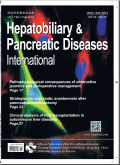- 钛学术文献服务平台 \
- 学术期刊 \
- 医药卫生期刊 \
- 内科学期刊 \
- 国际肝胆胰疾病杂志(英文版)期刊 \
null
Prognostic factors influencing outcome in adult liver transplantation using hypernatremic organ donation after brain death
基本信息来源于合作网站,原文需代理用户跳转至来源网站获取
摘要:
Background: Hypernatremic donors was regarded as the expanded criteria donors in liver transplantation. The study was to investigate the effects of donor hypernatremia on the outcomes of liver transplantation and identify the prognostic factors possibly contributing to the poor outcomes.Methods: Donor serum sodium levels before procurement were categorized as normal sodium ( < 155 mmol/L), moderate high sodium (155–170 mmol/L), and severe high sodium ( ≥ 170 mmol/L). Fur- thermore, we subdivided the 142 hypernatremic donors ( ≥ 155 mmol/L) into two subgroups: subgroup A, the exposure time of liver grafts from hypernatremia to reperfusion was < 36 h; and subgroup B, the exposure time was ≥ 36 h. The outcomes included initial graft function, survival rates of grafts and recipients, graft loss and early events within the first year following liver transplantation. Results: There were no significant differences in the 1-year survival rates of grafts and recipients, 1-year graft loss rates and early events among the normal, moderate high and severe high sodium groups. How- ever, the overall survival rates of grafts and recipients in subgroup A were significantly higher than those in subgroup B. Cox model showed that the exposure time (HR = 1.117; 95% CI: 1.053–1.186; P < 0.001), cold ischemia time (HR = 1.015; 95% CI: 1.006–1.024; P = 0.001) and MELD (HR = 1.061; 95% CI: 1.003–1.121; P = 0.037) were the important prognostic factors contributing to the poor outcomes of recipients with hypernatremic donors. Conclusions: The level of donor sodium immediately before organ procurement does not have negative effects on the early outcomes following adult liver transplantation. For hypernatremia liver donors, min- imization of the exposure time from hypernatremia to reperfusion is critical to prevent graft loss.

推荐文章
期刊_丙丁烷TDLAS测量系统的吸收峰自动检测
带间级联激光器
调谐半导体激光吸收光谱
雾剂检漏 中红外吸收峰 洛伦兹光谱线型
不同盐度、温度及光照对漂浮浒苔生理生态的影响
浒苔
盐度
温度
光照
生理生态
期刊_联合空间信息的改进低秩稀疏矩阵分解的高光谱异常目标检测
高光谱图像
异常目标检测 低秩稀疏矩阵分解 稀疏矩阵 残差矩阵
内容分析
关键词云
关键词热度
相关文献总数
(/次)
(/年)
文献信息
| 篇名 | Prognostic factors influencing outcome in adult liver transplantation using hypernatremic organ donation after brain death | ||
| 来源期刊 | 国际肝胆胰疾病杂志(英文版) | 学科 | |
| 关键词 | |||
| 年,卷(期) | 2020,(4) | 所属期刊栏目 | |
| 研究方向 | 页码范围 | 371-377 | |
| 页数 | 7页 | 分类号 | |
| 字数 | 语种 | 英文 | |
| DOI | |||
五维指标
引文网络
引文网络
二级参考文献 (87)
共引文献 (14)
参考文献 (20)
节点文献
引证文献 (0)
同被引文献 (0)
二级引证文献 (0)
1900(2)
- 参考文献(0)
- 二级参考文献(2)
1986(1)
- 参考文献(0)
- 二级参考文献(1)
1991(1)
- 参考文献(1)
- 二级参考文献(0)
1994(1)
- 参考文献(1)
- 二级参考文献(0)
1996(1)
- 参考文献(0)
- 二级参考文献(1)
1997(1)
- 参考文献(1)
- 二级参考文献(0)
1998(1)
- 参考文献(0)
- 二级参考文献(1)
1999(1)
- 参考文献(1)
- 二级参考文献(0)
2000(2)
- 参考文献(0)
- 二级参考文献(2)
2001(3)
- 参考文献(1)
- 二级参考文献(2)
2002(1)
- 参考文献(0)
- 二级参考文献(1)
2003(3)
- 参考文献(1)
- 二级参考文献(2)
2004(3)
- 参考文献(1)
- 二级参考文献(2)
2005(2)
- 参考文献(1)
- 二级参考文献(1)
2006(4)
- 参考文献(0)
- 二级参考文献(4)
2007(5)
- 参考文献(1)
- 二级参考文献(4)
2008(13)
- 参考文献(1)
- 二级参考文献(12)
2009(6)
- 参考文献(0)
- 二级参考文献(6)
2010(10)
- 参考文献(1)
- 二级参考文献(9)
2011(11)
- 参考文献(0)
- 二级参考文献(11)
2012(20)
- 参考文献(0)
- 二级参考文献(20)
2013(10)
- 参考文献(4)
- 二级参考文献(6)
2014(1)
- 参考文献(1)
- 二级参考文献(0)
2015(2)
- 参考文献(2)
- 二级参考文献(0)
2017(1)
- 参考文献(1)
- 二级参考文献(0)
2019(1)
- 参考文献(1)
- 二级参考文献(0)
2020(0)
- 参考文献(0)
- 二级参考文献(0)
- 引证文献(0)
- 二级引证文献(0)
引文网络交叉学科
相关学者/机构
期刊影响力
国际肝胆胰疾病杂志(英文版)
主办单位:
浙江大学医学院第一附属医院
出版周期:
双月刊
ISSN:
1499-3872
CN:
33-1391/R
开本:
大16开
出版地:
浙江省杭州市庆春路79号
邮发代号:
创刊时间:
2002
语种:
eng
出版文献量(篇)
1879
总下载数(次)
0
期刊文献
相关文献
推荐文献
- 期刊分类
- 期刊(年)
- 期刊(期)
- 期刊推荐
国际肝胆胰疾病杂志(英文版)2022
国际肝胆胰疾病杂志(英文版)2021
国际肝胆胰疾病杂志(英文版)2020
国际肝胆胰疾病杂志(英文版)2019
国际肝胆胰疾病杂志(英文版)2018
国际肝胆胰疾病杂志(英文版)2017
国际肝胆胰疾病杂志(英文版)2016
国际肝胆胰疾病杂志(英文版)2015
国际肝胆胰疾病杂志(英文版)2014
国际肝胆胰疾病杂志(英文版)2013
国际肝胆胰疾病杂志(英文版)2012
国际肝胆胰疾病杂志(英文版)2011
国际肝胆胰疾病杂志(英文版)2010
国际肝胆胰疾病杂志(英文版)2009
国际肝胆胰疾病杂志(英文版)2008
国际肝胆胰疾病杂志(英文版)2007
国际肝胆胰疾病杂志(英文版)2006
国际肝胆胰疾病杂志(英文版)2020年第6期
国际肝胆胰疾病杂志(英文版)2020年第5期
国际肝胆胰疾病杂志(英文版)2020年第4期
国际肝胆胰疾病杂志(英文版)2020年第3期
国际肝胆胰疾病杂志(英文版)2020年第2期
国际肝胆胰疾病杂志(英文版)2020年第1期

 免费查重
免费查重










